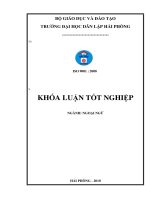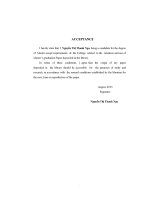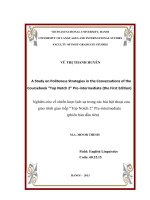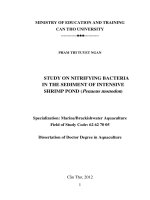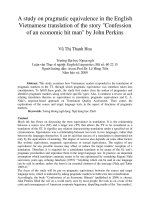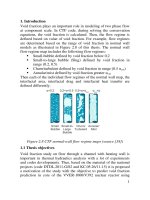Study on nutritional components in the cultivation mediums of cordyceps militaris
Bạn đang xem bản rút gọn của tài liệu. Xem và tải ngay bản đầy đủ của tài liệu tại đây (1.34 MB, 43 trang )
VIETNAM NATIONAL UNIVERSITY OF AGRICULTURE
FACULTY OF BIOTECHNOLOGY
---------- ----------
GRADUATION THESIS
STUDY ON NUTRITIONAL COMPONENTS IN THE
CULTIVATION MEDIUMS OF CORDYCEPS
MILITARIS
Student Name
: NGUYEN THI THUY
Student Code
: 620636
Class
: K62CNSHE
Supervisior
: NGUYEN VAN GIANG Assoc. Prof.
Hanoi – 2022
COMMITMENT
I hereby declare that all the data and the results that I have provided in
this thesis are truthful, accurate, and not used in any other reports.
I also assure that any help in this thesis has been greatly appreciated
thankful and the information cited has been acknowledged.
Hanoi, May, 2022
Student
Nguyen Thi Thuy
i
ACKNOWLEDGEMENTS
First and foremost, I have to thank the Vietnam National University of
Agriculture for giving me a chance to study in a professional environment that
provided me the sufficient knowledge throughout four and a half academic
years.
I would like to express my endless thanks and gratitude to my supervisor
Assoc. Prof Nguyen Van Giang . His kindly support and continuous advice went
through the process of completion of my thesis. Without his motivation and
instructions, the thesis would have been impossible to be done effectively.
I would like to thanks to everyone at Vietnam Institute of Medicinal
Herbs for their encouragement and guidance for my thesis.
Last but not least, my special thanks approve to my parents and my
friends for their endless love, and care and have most assistance and motivation
during the process of completed graduate thesis
Hanoi, May, 2022
Student,
Nguyen Thi Thuy
ii
ABSTRACT
Cordyceps militaris is an entomopathogenic fungus with many medicinal values
similar to Cordyceps sinensis and has been used for a long time in traditional
medicines. Different from Cordyceps sinensis, which has very low mass
production and only grows in natural environment, the fungus Cordyceps
militaris can be farmed in artificial conditions. Therefore, collecting of technical
information and researches will help promoting the production of Cordyceps
militaris in Vietnam to satisfy the demand of national and abroad markets. This
study evaluated the role of Cordyceps militaris in modern medicine based on
summing up the scientific research results, as well as assessing the biological
characteristics and the effects of the cultivating conditions for Cordyceps
militaris to develop farming processes in our country, which will bring essential
economic benefits for local producers. Results from scientific publications
showed that there had been many researches confirming the potential
applications of C.militaris in illness treatment, also it was widely used in the
modern pharmaceutical industry, such as cancer treatment, immunomodulatory,
impaired liver and kidney function, etc. (Shonkor, et al., 2010; Shin, et al.,
2009). For the production of C.militaris in artificial conditions, the strict control
of environmental conditions such as fungal seeds, temperature, humidity, light,
and nutrients was found as essential to maintain the yield and quality C.militaris.
iii
CONTENTS
COMMITMENT ................................................................................................... i
ACKNOWLEDGEMENTS ................................................................................. ii
ABSTRACT ........................................................................................................ iii
LIST OF ABBREVIATIONS ............................................................................. vi
LIST OF TABLES ............................................................................................. vii
LIST OF FIGURES ........................................................................................... viii
I. INTRODUCTION .............................................................................................1
1.1. Introduction .................................................................................................... 1
1.2. Research purpose............................................................................................ 2
1.3. Location and time studies............................................................................... 2
II. LITERATURE REVIEW .................................................................................3
2.1. General introduction to Cordyceps militaris(C.militaris).............................. 3
2.1.1. Classification and description of C.militaris............................................... 3
2.1.2. The life cycle of C.militaris ........................................................................ 4
2.1.3. Nutritional value of Cordyceps ................................................................... 5
2.1.4. Medicinal value of C.militaris .................................................................... 5
2.2.Research situation of C.militaris ..................................................................... 9
2.2.1. Research situation of C.militaris in the world ............................................ 9
2.2.2. Research situation of C.militaris in Vietnam ........................................... 10
III. MATERIALS AND METHODS ................................................................. 12
3.1. Materials and equipment .............................................................................. 12
3.1.1. Materials .................................................................................................... 12
3.1.2. Equipment ................................................................................................. 13
3.2. Methods ........................................................................................................ 13
3.2.1. Culture conditions ..................................................................................... 13
3.2.2. Substrate preparation and cultivation ......................................................... 14
IV. RESULTS AND DISCUSSION .................................................................. 16
iv
4.1. Effect of different propagation solid media composition on the growth
rate and characteristics of C.militaris VTV.1 strain ................................ 16
4.2. Effects of different liquid medium components on the propagation of
C.militaris VTV.1 strain .......................................................................... 18
4.3. Cultivation characteristics of C.militaris VTV1 strain on different
nutrient medium ...................................................................................... 21
V. CONCLUSIONS ........................................................................................... 28
VI. REFERENCES............................................................................................. 29
v
LIST OF ABBREVIATIONS
Abbreviations
Explaination
CME
Cordyceps militaris Extract
CMP
Cordyceps militaris prote
NAA
Naphthaleneacetic acid
CS-Cr
Cordyceps sinensis crysta
WE
HPLC
Water extract
High-performance liquid
chromatography
et al
Et alia
vi
LIST OF TABLES
Table 1. Summary of various pharmacological and therapeutic effects
of Cordyceps sp..................................................................................... 6
Table 2. Level 1 propagation medium ................................................................ 12
Table 3. Level 2 propagation medium ................................................................ 12
Table 4. Production medium ............................................................................... 13
Table 5. The growth and characteristics of the mycelia was different on 6
nutrient media. .................................................................................... 16
Table 6. The growth and characteristics of the fruiting body was different on
6 nutrient medium. .............................................................................. 23
vii
LIST OF FIGURES
Figure 2.1. Natural (A) and cultivated (B) C.militaris. ........................................ 4
Figure 4.1. C.militaris VTVT1 strain in different medium on the 5th days .......... 17
Figure 4.2. C.militaris VTVT1 strain in medium F1 and F2 on the 5th days ....... 18
Figure 4.3. C.Militaris VTVT1 strain in 6 liquid mediums on the 7th days ......... 19
Figure 4.4. The mycelial dry weight of Cordyceps militaris cultivated in
submerged culture ............................................................................... 20
Figure 4.5. C.Militaris VTV. 1 strain was cultured in 15 different production
mediums after 90 days ........................................................................ 21
Fig 4.6.Characteristics of the fruiting body of Cordyceps militaris strain
cultured in 15 mediums; A. Length of fruiting body (Cm); B.
Weight of fruiting body (g/box); C. Weight of dried fruiting body
(g) ........................................................................................................ 25
Fig 4.7. Cordycepin content of C.militaris VTV.1 strain cultured in 5
mediums .............................................................................................. 26
viii
I. INTRODUCTION
1.1. Introduction
Cordyceps spp. mushrooms, classified into the Ascomycota group, have a
long tradition of use as a natural agent in Asian ethnomedicine because of their
adaptogenic and tonic effects and their ability to reduce fatigue and stimulate the
immune system in humans.
Cordyceps is a broad term describing a group of ascomycetous fungi that
have carved out a niche as endoparasites primarily of arthropods and also as
symbionts of the ascomycete truffle genus Elaphomyces. So far, 540 species
have been reported as cordyceps. The term Cordyceps is derived from the Latin
words, ‘cord’ and ‘ceps’, respectively meaning ‘club’ and ‘head’.
Among the numerous, approximately 500, species of Cordyceps, most
scientific research has been conducted on Cordyceps sinensis, which is included
in the Chinese Pharmacopoeia (2015), and its adenosine concentration is
considered as the main quality indicator. Considering several complications
regarding C.sinensis, the species C.militaris has attracted more attention from
scientists and the industry over recent years.
C.sinensis is an authorized ingredient in food and dietary supplements in
the European Union (EU), and it is included in European Commission (EC) and
European Food Safety Authority (EFSA) documents such as the Novel Foods
Catalogue, Compendium of Botanicals. Health claims for C.sinensis have been
proposed in the past, such as that C.sinensis possesses antioxidant properties
(400–800 mg/day), stimulates the immune system and increases performance
and endurance during exercise,...
Because of the limited resources of C.sinensis, endemic occurrence,
unique growth pattern and biology of its life cycle in the ecosystem, the longterm process of symbiosis between the fungus and the larva (from autumn to
spring) is time-consuming, and the harvesting process of this species from its
natural site results in a very high price. Obtaining this species from the natural
1
environment has become insufficient to meet the growing demand for raw
materials for the production of dietary supplements, nutraceuticals and
functional foods, especially in Asia, the United States and Europe. The solution
to this issue is a related species, namely C.militaris (L.) Fr., which can be grown
and obtained in vitro. C.militaris is an alternative to C.sinensis because the
qualitative and quantitative composition of bioactive substances from in vitrocultivated C.militaris does not differ from the content of these substances in
C.sinensis fruiting bodies.
There have been several successful studies on cultivating cordyceps
(C.militaris) in an artificial environment, in the world and Vietnam. However,
the transfer of farming technology is quite expensive, so the price of cultivated
C.militaris mushroom products is sold at a relatively high price.
With the goal of producing C.militaris at a reasonable price so that many
classes of people can access this valuable source of medicinal herbs in disease
prevention, treatment and health promotion, the topic "Study on nutritional
components in the cultivation medium of Cordyceps militaris” was carried out.
1.2. Research purpose
Determination of composition of solid media for propagation of
C.militaris VTVT.1 strain
Determination of composition of liquid media for fermentation of
C.militaris VTVT.1 strain
Determination of nutritional components added to the culture medium for
the fruiting bodies of C.militaris VTV.1 strain.
1.3. Location and time studies
Location: This study was conducted in the laboratory of the Viet Nam
Institure of Medicinal Herbs
Time: Study was conducted from 10/2021 to 4/2022.
2
II. LITERATURE REVIEW
2.1. General introduction to Cordyceps militaris(C.militaris)
2.1.1. Classification and description of C.militaris
The
genus Cordyceps is
one
of
the
largest
genera
in
the
family Clavicipitaceae, containing over 750 species, and being extremely
diverse in terms of the number of species, their morphology and acclimatization
on varied hosts (Kim, et al. 2010; Sung, et al. 2011). These diverse species are
mostly distributed in Asian countries (such as Korea, Japan, Nepal, China), and
other parts of the world in humid temperate and tropical habitats. Occurrence of
a variety of species in different environmental conditions throughout the world
indicates its global distribution (Hajek, et al. 1994).
Cordyceps militaris is a species in Kingdom: Fungi, Division:
Ascomycota, Class: Sordariomycetes, Order: Hypocreales,
Family:
Cordycipitaceae, Genus: Cordyceps, Species: C.militaris (Kobayasi, et al.
1982). It was originally described by Carl Linnaeus in 1753 as Clavaria
militaris. The fungus forms 1–8 cm high, club-shaped and orange/red fruiting
bodies, which grow out of dead underground pupae. The club is covered with
the stroma, into which the actual fruit bodies, the perithecia, are inserted. The
surface appears roughly punctured. The inner fungal tissue is whitish to pale
orange (Davis, et al. 2012)
3
Figure 2.1. Natural (A) and cultivated (B) C.militaris.
(source: />
2.1.2. The life cycle of C.militaris
Like most other Cordyceps species, C.militaris is an entomopathogen. It
primarily infects the pupae stages-in the ground-of various Lepidopteran
species, multiply
ing in the host over winter. The overgrowth of hyphae
eventually kill the insect, after which club-like stromata erupt from the body and
through the soil (Kobayasi, et al. 1982; Kamble, et al. 2012).The sexual
perithecial stroma is generally bright yellow or orange.
The mechanism of infection for C.militaris is thought to be similar to
others across the Hypocreales order of endoparasites. A spore(s) will stick to the
exoskeleton of the host—generally a larva pupating underground—forming a
short germ tube with an appressorium. An infection peg formed on the ventral
side of the appressorium penetrates the host’s exoskeleton using both
mechanical pressed and lipases and/or proteases. Once inside, the hyphae of
C.militaris will proliferate into an endosclerotium, appearing as a solid white
mass of mycelium in one autopsy of an infected host (Kamble, et al. 2012). This
4
proliferation of the mycelium kills the host as the biomass replaces the host’s
organs. From the overwintering endosclerotium, stromata erupt from host and
protrude from the ground, usually late summer or fall.
2.1.3. Nutritional value of Cordyceps
In Cordyceps, there occurs a wide range of nutritionally important
components including various types of essential amino acids, vitamins like B1,
B2, B12 and K, different kinds of carbohydrates such as monosaccharide,
oligosaccharides and various medicinally important polysaccharides, proteins,
sterols, nucleosides, and other trace elements (Hur, 2008, Yang, et al. 2009, Li,
et al. 2011). In the fruiting body and in the corpus of C.militaris, the reported
total free amino acid content is 69.32 and 14.03 mg/g, respectively. The fruiting
body harbors many abundant amino acids such as lysine, glutamic acid, proline
and threonine as well. The fruiting body is also rich in unsaturated fatty acids
(e.g., linoleic acid), which comprises of about 70 % of the total fatty acids.
There are differences in adenosine (0.18 and 0.06 %) and Cordycepin (0.97 and
0.36 %) contents between the fruiting body and the corpus, respectively (Hur,
2008).
2.1.4. Medicinal value of C.militaris
Cordyceps species is also known as traditional Chinese medicine (TCM)
as it has wide applications in pharmaceutical and health sector (Ng ,T, et al.
2005). The studies by many researchers in the past on Cordyceps have
demonstrated that it has anti-bacterial, anti-fungal, larvicidal, anti-inflammatory,
anti-diabetic,
anti-oxidant,
anti-tumor,
pro-sexual,
immunomodulatory, anti-HIV and many more activities(Table 1).
5
apoptotic,
Table 1. Summary of various pharmacological and therapeutic effects
of Cordyceps sp.
Pharmacolog Active
ical effect
content
of Cordyceps
Animal/tissu
e studied
Active dose
Experimenta
l time period
References
Antiangiogenic
CME
HUVECs
100–
200 mg/L
After 3–6 h
(Yoo, Shin et
al. 2004)
Antitumor/antiproliferatory
CMP
MCF-7
(breast
cancer), 5637
(bladder
cancer) and
A-549 (lung
cancer)
15 μM
72 h
(Park, Na et
al. 2009)
Aqueous
extract of C.
militaris
Nude mice
with NCIH460 cell
At 150 and
300 mg/kg/da
y
4 weeks
(Park, Na et
al. 2009)
WE of C.
sinensis
LLC and B16
cells
100 mg/kg in
LLC, 100 or
200 mg/kg in
B16
20 and
26 days
(Nakamura,
Yamaguchi et
al. 1999)
Cordycepin
5637 and T24 cells
100 and
200 μM
48 h
(Lee, Kim et
al. 2010)
etOAc extract
of C. sinensis
HL-60 cells
ED50 ≤25 μg/ 2 days
ml
(Zhang, Wu et
al. 2004)
Aqueous
extract of C.
militaris
MDA-MB231
0.8 mg/ml
24 h
(Jin, Kim et
al. 2008)
Paecilomyces
hepiali (deriv
ative of C.
sinensis)
extract
A549
2–4 mg/ml
48–72 h
(Thakur, Hui
et al. 2011)
Water extract A549
of C. militaris
2 μg/ml
48 h
(Park, Na et
al. 2009)
Anti fatigue
Polysaccharid
e
Mice
200 mg/kg
For 21 days
(Li and Li
2009)
Anti malaria
Cordycepin
Erythrocytic
stages of P.
knowlesi (in
vitro) and P.
In vitro
106 M and in
vivo
50 mg/kg
In vitro 4 h
(Trigo,
Gutteridge et
al. 1971)
Anti
metastasis
Induce
apoptosis
6
Pharmacolog Active
ical effect
content
of Cordyceps
Animal/tissu
e studied
Active dose
Experimenta
l time period
References
berghei (in
vivo)
Anti fungal
Cordycepin
Murine Model 1.5 mg/kg/day 30 days
(Sugar and
McCaffrey
1998)
Hypolipidemi
c
Exo
polysaccharid
e
Rats
50–100 mg/kg 2 weeks
(Yang, Ha et
al. 2000)
Increase
hepatic
energy
metabolism
and blood
flow
Cordyceps
sinensis Extra
ct
Mice
200 mg/kg/dai 4 weeks
ly
(Manabe,
Azuma et al.
2000)
Human
peripheral
blood
0.025–0.1 mg
–
(Kuo, Chang
et al. 2007)
Mouse
splenocytes
5 μg/ml
72 h
(Jeong, Seo et
al. 2012)
C.militaris wa Murine
ter extract
macrophage
1,250 μg/ml
24 h
(Jo, Choi et
al. 2010)
Constituents
isolated
from C.milita
ris
Ranging from
6.3 to
20 μg/ml
24 h
(Rao, Fang et
al. 2010)
C.militaris ext HUVECs
ract reduce
oxidative
stress,
induced by
high glucose
concentration
25 μg/ml
12–36 h
(Chu, Chien
et al. 2011)
Fractions
of C.militaris
as CMESS
and
Cordycepin
50 and
0.2 mg/kg,
respectively
7 days
(Yun, Han et
al. 2003)
10 g/boar
2 months
(Lin, Tsai et
al. 2007)
Immunomodu Polysaccharid
latory
e from C.
sinensis
Purified
Cordycepin
from C.
militaris
Anti
inflammatory
Anti
Diabetic/Hyp
oglycemic
Spermatogeni
c
LPS/IFN-γ
stimulated
Macrophage
cells
Mice
CM mycelium Sub fertile
powder
boars
7
Pharmacolog Active
ical effect
content
of Cordyceps
Animal/tissu
e studied
Active dose
Experimenta
l time period
References
Steroidogenes CS
is
Normal
mouse leydig
cells
3 mg/ml
2–3 h
(Hsu, Tsai et
al. 2002)
24 h
(Pan, Lin et
al. 2011)
Anti-fibrotic
Cordycepin
MA-10 mouse 100 μM
leydig tumor
cells
Cordycepin
Human
dermal
fibroblasts
50–100 μM
24 h
(Lee, Kim et
al. 2009)
EPC
from C.milita
ris
Rats
30 mg/kg/day
4 weeks
(Nan, Park et
al. 2001)
1–15 min
(Zhu, Halpern
et al. 1998)
3 years and
observed
consecutively
for 5 years
(Lan 2002)
Cardiovascula Cs-4
r effects
Renal
protection
Cordyceps Po
wder
LN Patients
2–4 g/day
cordyceps
powder, and
artemisinin
0.6 g/day
Erythropoiesi
s
CS-Cr
LACA
Mouse, in
vivo and vitro
>150 mg/kg
5 consecutive (Li, Chen et
(vivo) 150–
daily
al. 1993)
200 μg/ml
treatment
(vitro)
(source:n />
Cordyceps has a long history of use as a lung and kidney tonic, and for
the treatment of chronic bronchitis, asthma, tuberculosis and other diseases of
the respiratory system. The cardiovascular effects of Cordyceps are being
noticed more frequently by researchers as it works through variety of possible
ways either by lowering high blood pressure via direct dilatory effects or
mediated through M-cholinergic receptors resulting in improvement in the
coronary
and
cerebral
blood
circulation
(Zhu
J.S,
et
al.
1998).
Thus, Cordyceps has implications at the therapeutic level as well by rectifying
the
abnormalities
in
rhythmic
contractions
(also
known
as
cardiac
arrhythmia). Cordyceps extract has also been found as a promising source to
8
increase cardiac output up to 60 % in augmentation with conventional treatment
of chronic heart failure (Chen, 1995). The product from wild type and
cultured Cordyceps has also been shown to significantly decrease blood
viscosity and fibrinogen levels preventing myocardial infarction (Zhu J.S, et al.
1998).According to recent researches, C.militaris might be used for the
treatment of the COVID-19 for reducing inflammation and fibrosis, increasing
immune response and antiviral effect (MA Kaymakci 2022). It may be a better
option to use anciently known and well-studied agents rather than discovering
new ones to find a rapid treatment for COVID-19 in these pandemic times.
2.2.Research situation of C.militaris
2.2.1. Research situation of C.militaris in the world
There are many studies on C.militaris that have been studied and
published in many reputable journals.
Compared with C.siensis, C.militaris is easier to grow in both liquid and
solid media with different carbon and nitrogen sources. Studies have proved that
C.militaris contains many active ingredients with medicinal potential such as
cordycepin, ergosterol, mannitol and many types of polysaccharides that affect
many organ systems in the body and prevent many diseases used for a variety of
therapeutic purposes (Das et al., 2010; Gu et al., 2007; Reis et al., 2013).
Due to the high host specificity and the great influence of the growth
environment, C.militaris species is difficult to find in nature. Therefore, the
cultivation of C.militaris to obtain biomass and bioactive components attracts
many scientists. Several studies have demonstrated that the bioactive
components obtained between wild and cultivated C.militaris lines are similar
(Tong et al., 1997; Jiang, X.L et al., 1999; Wang. et al., 2012).
The results of the study carried out by Wen et al. (2014) showed that the
optimal medium composition for fruiting body formation was brown rice
medium supplemented with 40 g/l glucose, 5 g/l peptone, 1.5 g/l MgSO4.7H2O,
9
1.5 g /l K2HPO4 and 1.0 mg/l NAA and the optimal medium for Cordycepin
production was brown rice supplemented with 10 g/l glucose, 10 g/l peptone, 1.0
g/l MgSO4.7H2O, 1.0 g /l K2HPO4 and 1.0 mg/l NAA. While the study by Lim
et al., (2012) and Dong et al., (2012) showed that soybeans and wheat fortified
with nutrients were the best substrates for the formation of adenosine,
cordycepin and D-mannitol of C.militaris when grown on substrate medium.
In addition, the addition of silkworm pupae to brown rice medium to
produce C.militaris fruit bodies was shown to be superior to other substrates
used (Shrestha et al., 2004a, b, 2005a, b; Sung et al., 2006a, b; Zhao et al.,
2006a; Jin et al., 2009).
2.2.2. Research situation of C.militaris in Vietnam
There have been very few studies on C.militaris in Vietnam recently.
The authors Pham Quang Thu, Le Thi Xuan and Nguyen Manh Ha
studied the biological characteristics of the mycelium in pure cultures of
Cordyceps militaris fungi, published in the Journal of the Vietnam Academy of
Forestry Sciences in year 2012
(source:
/>
thuan-khiet-cac-chung-nam-dong-trung-ha-thao-cordyceps-militaris-l-fr-link/)
In 2016 Trinh Thi Xuan and Le Tuan Anh successfully studied the
suitable environment for the production of the fruiting bodies of the medicinal
mushroom Cordyceps militaris.
(source: />
The authors Luyen Thi Nguyen, Ve Van Le, Bich Thuy Thi Nguyen,
Nghien Xuan Ngo, Huyen Trang Thi Nguyen, Quan Dinh Nguyen, Sikandar
Mulla (2020) have studied the topic "Cultural characteristics and cordycepin
production of some Cordyceps militaris strains under artificial cultivation
conditions"
10
(source:
/>
cordycepin-production-of-some-Cordyceps-militaris-strains-under-artificial-cultivationconditions,85,41015,0,1.html)
Currently, many companies and research institutes successfully produce
C.militaris. In which Thien Phuc Medicinal Herbs Joint Stock Company is
considered as the largest production company of Cordyceps militaris. Products
derived from cordyceps in Vietnam are very diverse such as: freeze drying
cordyceps, cordyceps in tablets or capsules, cordyceps in combination with
reishi, water-based cordyceps, etc. However, the common characteristics are
Cordyceps products relatively high cost.
11
III. MATERIALS AND METHODS
3.1. Materials and equipment
3.1.1. Materials
The breed of Cordyceps militaris : C.militaris VTV.1 strain provided by
Vietnam Institute of Medicinal Herbs
Medium components: brown rice, silkworm pupae, potato, soybeans, bean
sprouts, yeast extract, agar.
Table 2. Level 1 propagation medium
Formula
Medium components
1
N1
2
N1 + 10 gr silkworm pupae/L
3
10 gr silkworm pupae/L + 20gr agar
4
20 gr silkworm pupae/L + 20gr agar
5
30gr silkworm pupae/L + 20gr agar
6
200 gr potato + 20grsilkworm pupae + 20gr
agar
Table 3. Level 2 propagation medium
Formula
Medium components
1
N1
2
N1 + 20gr silkworm pupae/L
3
N1(- yeast extract) + 20gr silkworm
pupae/L
12
Table 4. Production medium
Formula
Medium components
1
P1
2
P1(-yeast extract)
3
30gr rice + 10 gr soybeans + 10 gr
silkworm pupae
4
30gr rice + 10 gr bean sprouts + 10
gr silkworm pupae
5
30gr rice+ 10 gr soybeans + 10 gr
bean sprouts
3.1.2. Equipment
Instruments: petri dishes, test tube, Erlenmeyer flask (500ml), inoculation
loops, alcohol burner.
Laboratory equipment: autoclave, precision balance scale, refrigerator and
freezer, drying oven, shaker incubator.
3.2. Methods
3.2.1. Culture conditions
3.2.1.1. Level 1 propagation medium
Accurately weigh the nutrient composition of the media (Table 2) mixed
with 0.2 liters of water and autoclaved at 115°C for 30 minutes, the nutrient
solution is evenly divided into Petri dishes (15 ml/dish), cooled, and stored at
room temperature. After activation, the C.militaris VTVT.1 strain was cut into
0.5 cm squares containing mycelia and placed in a petri dish. Then, Petri dishes
of level 1 propagation medium were grown at 23°C, under dark conditions
(Kamp, A. M., et al. 2002).
13
The diameter of the mycelia extension (cm) was measured at 5 days. The
morphological characteristics of mycelia such as texture, density, and color were
assessed by visual observations.
3.2.1.2. Submerged fermentation
Accurately weigh the nutrient composition of the medium (Table 3) with
2 liters of water and autoclaved at 115°C for 30 minutes. Inoculation of
C.militaris into the best studied medium for Cordyceps militaris (experiment
result 1). After 10 days for the fungus to produce a certain amount of mycelial, it
is transferred into the medium liquid to increase the mycelial (Sari, N., et al.
2016).
Using a inoculation loop to obtain a mycelial biomass from level 1
propagation medium and transferred into Erlenmeyer flack 300 ml of the
medium and kept on a rotary shaker incubator (120 rpm) at 18°C.
The density, size, and morphology of pellets were recorded for 7 days.
The dry weight of mycelial was determined following the protocol
reported by (Park, J.P., et al. 2001) The mycelial pellets were washed with
distilled water and dried overnight at 70°C until a constant weight was achieved.
3.2.2. Substrate preparation and cultivation
Experiments were arranged on 5 culture media (Table 4). Each fomula is
repeated 5 times.
Accurately weigh the nutrient composition of the medium into each box
and autoclaved at 115°C for 40 minutes. The liquid spawn (20ml) was
inoculated in the medium ( Shrestha, B., et al. 2012).
It will be grown through the following 2 stages:
Incubation stage: the boxes will be placed in complete darkness,
temperature 20°C, humidity 70-75% for 7 days.
Stage of fruiting care: after the mycelial have spread to the surface of the
substrate, proceed to the care phase to allow the fruiting body to develop.
14
Conditions for this stage are alternate lighting time 16/ 8 (700 lux), temperature
20 - 23°C, humidity 85 - 90%.
Monitoring and statistics on the development of fruiting bodies in the
following criteria: Time for the mycelia to fully covers the surface of the
medium, length of fruit bodies, dry and fresh weight of each box after 3 months
Quantification of cordycepin content
To evaluate the medicinal value of strain cultured in different mediums ,
the cordycepin content was quantified by HPLC. Powder of fruiting bodies (1 g)
was precisely weighed, added to 10 ml of 80% ethanol (v/v) in a 50 ml corning
polypropylene centrifuge tube, and sonicated for 30 minutes using an ultrasonic
machine. The extracted solution was filtered using a 0.22 μm cellulose acetate
membrane filter (Thermo Fisher Scientific). The standard for cordycepin was
obtained from Sigma-Aldrich. HPLC was performed on a Zorbax Eclipse
XDB18 column (250 × 4.6 mm; 5 μm) with a flow rate of 0.8 ml/min and an
injection amount of 20 μl. The mobile phase consisted of acetonitrile: water (8:
92, vol/vol). The detection wavelength was set at 260 nm.
15
IV. RESULTS AND DISCUSSION
4.1. Effect of different propagation solid media composition on the
growth rate and characteristics of C.militaris VTV.1 strain
C.militaris VTV.1 strain was cultured on 6 different types of media. The
results showed that the growth and development of the mycelial was different on
6 nutrient media.
Table 5. The growth and characteristics of the mycelia was different on 6
nutrient media.
Media
th
Diameter(mm) The characteristics of the mycelial after 5 days
1
23 ±2,0
Cottony texture , high density, abundant growth, and the
mycelia was orange-yellow in color
2
24±1,5
Cottony texture , high density, abundant growth, and the
mycelia was orange-yellow in color
3
18 ± 2,0
Floccose texture ,low density, regular growth, the mycelia
was orange-yellow in color
4
15 ± 1,0
Floccose texture ,low density, scarce growth, the mycelia
was white-yellow in color
5
22 ± 1,5
Floccose texture ,low density, scarce growth, the mycelia
was white-yellow in color
6
28 ± 2,0
Floccose texture ,low density, scarce growth, the mycelia
was orange-yellow in color
16


